When engineers at Hoover Dam determined that the original cast iron lantern rings built into some of its turbines needed to be replaced, they were looking for a solution to help them overcome the corrosion issues they experienced with the cast iron.
The maintenance team also faced another challenge. The Colorado River serves as a water source for the Hoover Dam hydropower station, and the water in this area is commonly referred to as "hard water" due to its high mineral content, specifically high levels of calcium and magnesium ions. Aluminium lantern rings that were first tried as a replacement, were corroded by chemical reactions with the minerals in the water.

Having used Vesconite Hilube bearing material in other applications, such as guides on their pressure relief valves, the engineers were familiar with the no-swell, non-corrosive properties of the material and also with Vesconite Bearings’ capability to create large-diameter parts such as these 44-inch diameter lantern rings (Ø1,100 mm). Vesconite Hilube also had the added advantage that it is not chemically attacked by the "hard water”.
 Monique Potgieter
Monique Potgieter
Two lantern rings were supplied, one of which was divided into two segments and another of which was divided into three segments. Like the lantern rings Vesconite Bearings makes for pumps, the large-diameter hydroelectric power plant lantern rings were easily machined and included the necessary flush holes that would cool the shaft on which they were located.
“Our experienced staff in the machine shop can machine these large-diameter parts with the necessary accuracy,” notes Monique Potgieter, the application engineer who assisted the Hoover Dam team with the design and supply of the lantern rings.
“Even though not all lantern rings are designed to run in close proximity to the shaft, it is important to know that our materials can be used with small clearances. This will result in better shaft support and stability, all the while you’ll have no worries of contact between the shaft and the lantern ring,” she says.
“Vesconite’s low-friction materials are non-galling, and occasional contact with the shaft will not result in damage,” Potgieter adds.
The two lantern rings were supplied in early 2022 and are the largest lantern rings Vesconite has produced to date.






